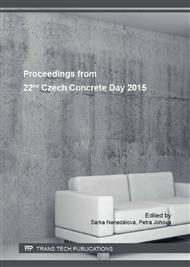[1]
Wang, X. Y. (2014). Properties prediction of Ultra High performance concrete using blended cement hydration model. Construction and Building Materials, 64, 1-10.
DOI: 10.1016/j.conbuildmat.2014.04.084
Google Scholar
[2]
Alqadi, A. N., Mustapha, K. N. B., Naganathan, S., & Al-Kadi, Q. N. (2013). Development of self-compacting concrete using contrast constant factorial design. Journal of King Saud University-Engineering Sciences, 25(2), 105-112.
DOI: 10.1016/j.jksues.2012.06.002
Google Scholar
[3]
Soudki, K. A., El-Salakawy, E. F., & Elkum, N. B. (2001). Full factorial optimization of concrete mix design for hot climates. Journal of Materials in Civil Engineering, 13(6), 427-433.
DOI: 10.1061/(asce)0899-1561(2001)13:6(427)
Google Scholar
[4]
Aldahdooh, M. A. A., Bunnori, N. M., & Johari, M. M. (2013). Evaluation of ultra-high-performance-fiber reinforced concrete binder content using the response surface method. Materials & Design, 52, 957-965.
DOI: 10.1016/j.matdes.2013.06.034
Google Scholar
[5]
Mahmud, G. H., Yang, Z., & Hassan, A. M. (2013). Experimental and numerical studies of size effects of Ultra High Performance Steel Fibre Reinforced Concrete (UHPFRC) beams. Construction and Building Materials, 48, 1027-1034.
DOI: 10.1016/j.conbuildmat.2013.07.061
Google Scholar
[6]
Al-Azzawi, A. A., Ali, A. S., & Risan, H. K. (2011). Behavior of Ultra High performance concrete structures. ARPN Journal of Engineering and Applied Sciences, 6(5), 95-109.
Google Scholar
[7]
Yu, R., Spiesz, P., & Brouwers, H. J (2014). Mix design and properties assessment of Ultra-High Performance Fibre Reinforced Concrete (UHPFRC). Cement and Concrete Research, 56, 29-39.
DOI: 10.1016/j.cemconres.2013.11.002
Google Scholar
[8]
Wang, C., Yang, C., Liu, F., Wan, C., & Pu, X. (2012). Preparation of ultra-high performance concrete with common technology and materials. Cement and Concrete Composites, 34(4), 538-544.
DOI: 10.1016/j.cemconcomp.2011.11.005
Google Scholar
[9]
Wille, K., & Boisvert-Cotulio, C. (2015). Material efficiency in the design of ultra-high performance concrete. Construction and Building Materials, 86, 33-43.
DOI: 10.1016/j.conbuildmat.2015.03.087
Google Scholar
[10]
Zain, M. F. M., Abd, S. M., Sopian, K., Jamil, M., & Che-Ani, A. I. (2008, October). Mathematical regression model for the prediction of concrete strength. In N. E. Mastorakis, M. Poulos, V. Mladenov, Z. Bojkovic, D. Simian, S. Kartalopoulos, .. & C. Udriste (Eds. ), WSEAS International Conference. Proceedings. Mathematics and Computers in Science and Engineering (No. 10). WSEAS.
Google Scholar
[11]
Mattacchione, A., & Mattacchione, L. (1995). CORRELATION BETWEEN 28-DAY STRENGTH AND DENSITY. Concrete International, 17(3).
Google Scholar
[12]
Arafa, M., Shihada, S., & Karmout, M. (2010). Mechanical properties of ultra high performance concrete produced in the Gaza Strip. Asian Journal of Materials Science, 2(1), 1-12.
DOI: 10.3923/ajmskr.2010.1.12
Google Scholar
[13]
Senthil Kumar, K., & Baskar, K. (2014). Response Surfaces for Fresh and Hardened Properties of Concrete with E-Waste (HIPS). Journal of Waste Management, (2014).
DOI: 10.1155/2014/517219
Google Scholar
[14]
Ma, J., Orgass, M., Dehn, F., Schmidt, D., & Tue, N. V. (2004, September). Comparative investigations on ultra-high performance concrete with and without coarse aggregates. In Proceedings International Symposium on Ultra High Performance Concrete (UHPC), Kassel, Germany.
DOI: 10.21838/uhpc.16728
Google Scholar
[15]
Mohammed, B. S., Abdullahi, M., & Hoong, C. K. (2014). Statistical models for concrete containing wood chipping as partial replacement to fine aggregate. Construction and Building Materials, 55, 13-19.
DOI: 10.1016/j.conbuildmat.2014.01.021
Google Scholar


